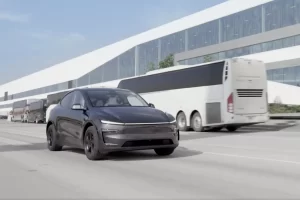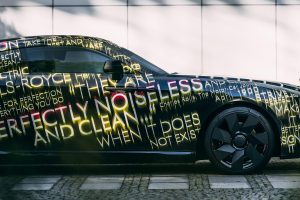The signs of an EV revolution were all there, but it seems like consumer demand for all-electric vehicles was still able to catch veteran automakers off guard. With Tesla currently commanding about 70% of the United States’ electric vehicle sales in the first half of the year, the race to catch up to the trailblazer is on — but it’s a lot easier said than done.
It’s a pretty insane thought today, but when Tesla announced its plans to build a dedicated battery factory to support the Model 3’s ramp, many were skeptical. Back then, many still questioned if there really was a demand for electric cars. This is not the case anymore today. If auto executives were not sure if there would be buyers for EVs before, now they’re worrying if they can build them fast enough.
Electric cars only account for about 6% of the United States’ overall vehicle sales, but this percentage has tripled in the past two years. Meanwhile, sales of other types of cars have declined, as per insights from research firm Motor Intelligence. This was represented by the fact that five of the six fastest-selling cars in the US were electric or plug-in hybrids. Tesla’s Model Y, a crossover, is on track to become one of the world’s best-selling cars.
ALL-IN ON EVS
Veteran automakers have expressed their intention to go all-in on EVs, and some, such as GM CEO Mary Barra, have even stated in the past that she believes General Motors can pass Tesla in the future. The same is true for executives from Ford and Volkswagen. But inasmuch as it’s easy to announce such an ambitious target, accomplishing it is a completely different matter.
GM, for example, started its recent EV push with the GMC Hummer EV and the Cadillac Lyric. GM received a lot of support from the Biden administration for its electric vehicle efforts, so much so that Biden dubbed Barra as a leader who electrified the auto industry. Yet, according to The Wall Street Journal, people familiar with the matter have noted that the production of the Hummer EV and Lyriq is still at rates of less than a dozen a day. This was despite the waiting lists of both vehicles stretching into the tens of thousands.
And it’s not just GM. Ford is somewhat in the same boat. The Ford F-150 Lightning is an acclaimed vehicle, and its order books are extremely long. The demand for the vehicle was so notable that Ford had to double its production target twice. In 2020, the company expected its lightning factory to produce 40,000 of the pickups per year, a target that was doubled last year. This past January, as the order books for the Lightning continued to grow, Ford doubled its target again to 150,000 trucks by summer 2023.
Ford’s head of EV programs Darren Palmer provided an idea of the speed at which Ford had to adjust its Lightning targets. “The cement had barely joined to some of the walls, and we were already expanding,” he said.
A RUSH FOR SUPPLIES
A lot of the challenges faced by veteran automakers were due to a lack of parts from the supply chain, as well as a struggle to secure as many batteries as possible. EVs use more computer chips than combustion-powered cars, which made things very challenging during the chip crisis faced by the entire industry. Electric cars also rely on batteries, so carmakers are now in a battery arms race of sorts in an effort to ensure that their EVs can be ramped.
Ultimately, the Journal noted that automakers are in their current situation because many have lowballed their early EV production estimates. Thus, when electric vehicles took off during the pandemic, many executives in the auto industry were caught off guard. Couple this with the fact that newcomers like Rivian and Lucid are also entering the fray, and the auto industry is looking more and more like it’s in the cusp of some real changes.
In a way, it’s simple. If veteran automakers would like to catch up to Tesla, they have to make electric cars that people want to buy. The success of non-Tesla EVs such as the F-150 Lightning, Mustang Mach-E, and the Hyundai Ioniq 5 show that the EV market has enough space for multiple carmakers. But with demand for EVs increasing now, some automakers may end up watching EV only competitors like Tesla increase their lead in the coming years.
The question of whether there is demand for EVs has long been settled. In a statement to the WSJ, Earl Stewart, a Florida-based Toyota dealer, noted that there’s actually a lot of interest in the bZ4X. However, the vehicle’s availability is just not there. Stewart noted that mass adoption of electric vehicles would need affordable electric cars. That being said, he has already taken the leap to EVs — he currently drives a Tesla Model S Plaid.
“Until they bring the prices down, it will just be people like me who can afford to buy EVs and who want to be the first on the block to drive one,” Stewart said.





